ANTENNE ANALYZER, VK5JST's AERIAL ANALYSER
![]() Correction of the diagrams: IC1d pin 2 = (-) and pin3 = (+)
Correction of the diagrams: IC1d pin 2 = (-) and pin3 = (+)
|
All modifications incorporated into one diagram. |
|
EXPERIENCE AND REVIEW
The designer calls this 'AERIAL ANALYSER' a simple tool with the accuracy of a grip dip meter. This is not doing justice to a cleverly designed piece of equipment. It compares favourably to many commercial analysers, even more so if one looks at the price – performance ratio. Most hams are mainly interested in low SWR @ 50 Ω and take measurements to they can adjust aerials or antenna tuners in the HF region. At times they are interested to know the input and output impedance of broadband amplifiers.
This is one option to homebrew at a reasonable price is a very useable piece of equipment and it has a professional look when finished. If one puts the kit together without making any mistakes then it will work perfectly first time round. A bonus is that the schematic is supplied and you’ll know it functions on the inside. And then afterwards you may opt to apply below mentioned modifications.
The range can be extended above 31 MHz by letting the oscillator works up to 60 MHz. At the high end of those frequencies the output on TP1 is too low to obtain reliable and useful measurements. For up to 50 MHz it is a useable and a worthwhile extension.
If you have to choose between a RF1 analyser or rolling your own from this kit then the latter is the better option.
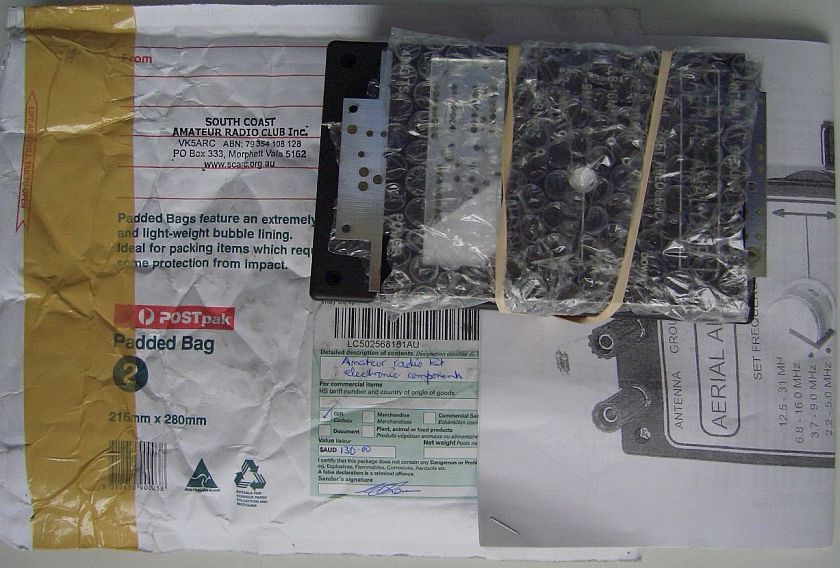
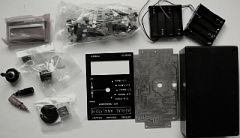
Spend 93 Euro to see this well packaged kit arrive 7 days later in The Netherlands from Australia.
OVERVIEW
|
|
The antenna analyser was constructed from the VK5JST design of 2004 whenever time permitted. You’ll read about this later on together with the experiments done. If you use google then you’ll find enough of the original kit documentation.
This tool is supplied as a complete kit, inclusive a plastic housing, front, double sided drilled PC board and all components, all screws, spacers, wire, feet, plugs, knobs, battery holders, diagram, construction notes etc. Nothing extra has to be purchased and world wide more than 1000 kits have been supplied. When it arrived no parts were missing and all components had the correct value. The cost of this was $ 130 Australian (approx. 93 Euro at the time of ordering). Put it together without any mistakes and it functions immediately after the simple calibration. My redesigned front (in the picture on the right) looks different from the original model. The "digit" switch was not required and the "power" switch was attached to the top of the PC board.
SUGGESTION
The rather small resistors are coded with 5 coloured bands and the difference between red, orange and brown is marginal at times. In spite of my many years of dealing with these things I still managed to put a 47 kΩ resistor in the location of a 4.7 kΩ resistor. Fortunately it was discovered in time and no debugging was required later on. Check the values with a multimeter before you solder them in.
BNC CONNECTOR

 The kit is supplied with two ordinary banana sockets however my preference is for a coaxial output. I adapted a BNC socket (fig») to this task, which required some innovation to mount D5, D6 and 2 × 100 Ω resistors.
The kit is supplied with two ordinary banana sockets however my preference is for a coaxial output. I adapted a BNC socket (fig») to this task, which required some innovation to mount D5, D6 and 2 × 100 Ω resistors.
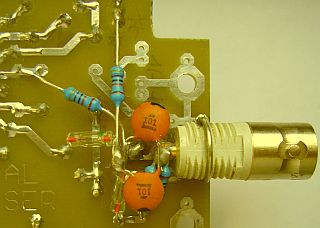
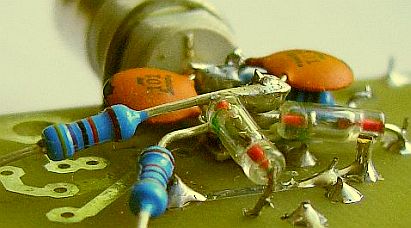
The tag-soldered modifications on the trackside increase the distance to the foil (component) side with the fibreglass pc board between.
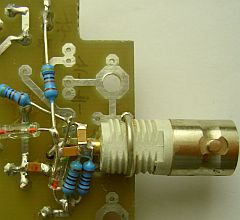
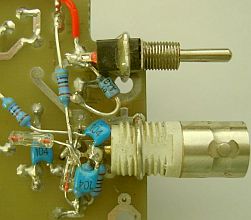
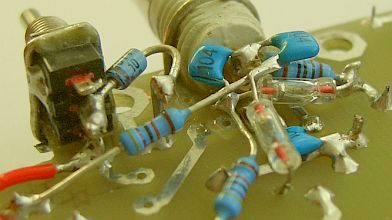
I replaced three 100 pF capacitors with some 50 nF SMD capacitors in order to keep the connections short. However this did not offer a lot of mechanical stability and later these SMD capacitors were replaced by the normal smaller 100 nF type. I placed the on-off switch next to the BNC connector because the BNC connector would offer some protection against accidentally switching the power on.
LCD CONNECTOR
|
|
The original front. |
The "simplified" front. |
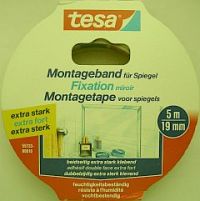
I found in the junk box a multiple computer connector and used that to connect the LCD to the PCB. It has 13 pins and the required 14th wire was created from some black hook-up wire and is used for the ground connection.
This connector is useful during experiments and when the LCD gets mounted later on. It is especially useful when the LCD gets mounted on the inside and I used double sided tape for this. This tape (fig») is normally used for mounting mirrors, very durable, very strong and water-resistant. The battery holders were attached to the cabinet using the same tape.
(This tape was selected because many years ago I attached a metal cabinet to the underside of my desk and it is still there, neither are I able to pull it off.)
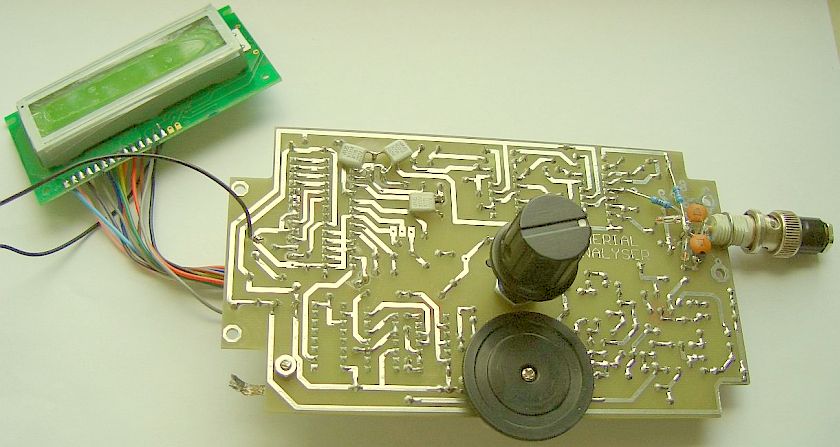
The BNC plug is a homebrew dummy load created with two 100 Ohm SMD resistors inside.
Extra 10 nF bypass capacitors for TP2, TP3 and TP4 were attached to the tracked side of the PC board.
CALIBRATION
Widely differing results appeared on the screen when measuring non-inductive 15, 50 and 150 Ω resistors at different positions of the bandswitch. Often a null resistance was reported when this was not appropriate. Probably this is the result of the deviation of the required values of the components in the measuring circuit. After extensive calibration adjustments I think the underlying cause is something different.
It looks like the design assumes that the TP2 and TP3 have half the voltage value of TP1. When the circuit diagram is closely studied then this seems to be unlikely. I adjusted TP2 and TP3 to the lower value of 2.14 V @ 2 MHz and this delivered an acceptable overall performance. You may want to experiment with 2.13 – 2.16 V instead of the originally specified 2.25 V.
|
Alternative calibration. |
Original calibration. |
|
(1) Apply 12 V to the PCB. |
(1) Apply 12 V to the PCB. |
|
(2) Connect non-inductive 50 Ω load across the terminals. |
(2) Connect non-inductive 50 Ω load across the terminals |
|
(3) Set the frequency to about 2 MHz. |
(3) Set the frequency to about 2 MHz. |
|
(4) Adjust the level of TP2 to exactly 4.5 V with P1. |
(4) Adjust the level of TP2 to exactly 4.5 V with P1. |
|
(5) Adjust the level of TP3 to exactly 2.14 V with P2. |
(5) Adjust the level of TP3 to exactly 2.25 V with P2. |
|
(6) Adjust the level of TP4 to exactly 2.14 V with P3. |
(6) Adjust the level of TP4 to exactly 2.25 V with P3. |
|
The alternative calibration gives the results that correspond closely to the results that I obtain with my "normal" SWR meter on my 5 band Vertical antenna. |
Original calibration see: "SET UP AND TESTING THE ANTENNA ANALYSER". |
RESULTS
|
|
|
These results were obtained by using the original calibration values. The frequency reported on the LCD screen (fig») deviates from the generated frequency. I used a "standard" 0.33 µH RFC for the range up to about 54 MHz.
A couple of non-inductive resistors (22, 50, 100 and 150 Ω) were measured at the highest and lowest band end for each position of the band switch. The maximum I measured was 54 MHz and that became inaccurate, but it might make a useful signal source. Up to 40 MHz was acceptable.
MODIFICATIONS
The oscillator drifts slightly. Likely not enough buffers following the oscillator cause this. The measurement results are not constant through all the ranges and this is the result of the different voltage levels offered to the measurement circuit. It was the intention to homebrew a solution but research on the internet revealed that two others already had come up with the answer.
|
|
The oscillator requires a separate 5 V dc stabilisation and ALC will ensure a more stable signal being offered to the measurement circuit.
Both («fig) improvements have been incorporated in the diagram. The modifications have been tested to make sure that they perform as expected. The adjustment of the 50 kΩ potentiometer is very sensitive and the last number, often even the last two numbers, on the display keep on changing.
|
This was the initial design. |
After applying the modifications suggested here the adjustment is no longer sensitive and the last number is either stable or moves up/down by a single amount.
Originally I was considering (fig») a buffer in line with a MAR type amplifier. This has the advantage that less changes to the printed circuit tracks.
In practice adding the MAR amp between Q7 and Q8 did not meet the expectations and similar results were obtained using other discrete amplifiers. The voltage level on TP1 becomes too high and this becomes too much for the PIC processor to function properly.
FINAL MODIFICATION (at least for the moment)

Adding an electrolytic to D1 and D2 cured the constant flickering of the last few digits in the display. A («fig) 5 V stabiliser, 47 µF electrolytic and a 10 pF trimmer were mounted at first. When the Xtal was adjusted to 16 MHz then the trimmer was about 5 pF. Without the trimmer the frequency was about 2 kHz too high.
|
First this was implemented and it works fine but later there came an update. Take note that in my version the 47 k pot is always turned to maximum value and therefore no longer required to be a potentiometer. |
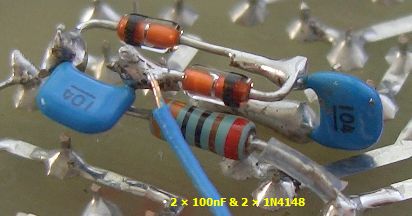
ALC applied to the oscillator may influence the stability and the regulation of a buffer amplifier is more appropriate. Q9 and Q10 together make up a cascade amplifier where Q10 is bypassed for HF. Q10 operates in an grounded base configuration with low input impedance. One of the possibilities to control the amplification is seen in the diagram.
The signal on TP1 is amplified by IC1a and IC1d and two 1N4148 diodes are used to control the signal level at the emitter of Q10. The control voltage to the diodes is supplied through a 1 kΩ resistor and TP1 maintains its sinusoidal shape.
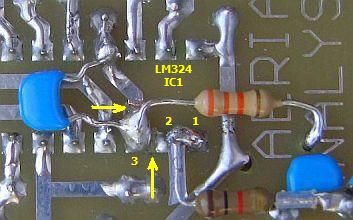
The track between pin 2 and 3 on IC1 has to be cut (fig») from earth and each other in order to activate IC1d. I used a dentist’s drill for this. Afterwards pin 1 and pin 2 are connected.
The 560 Ω resistor connected to the emitter of Q7 (and base of Q6) is replaced by 330 Ω.
The battery level indicated in the LCD was too low and it was corrected experimentally with a 1 MΩ on the tracked side of the PCB and parallel to the 16 kΩ resistor.
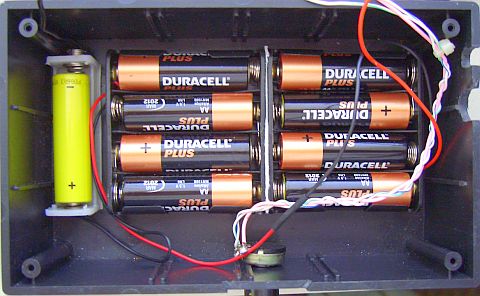
When the supplied voltage drops then the accuracy of the analyser suffers. Instead of using a series diode to protect the analyser against reverse voltage a reverse connected diode across the power connection is selected. The 200 mA fuse is based on total consumption of the analyser inclusive the back lightning of the LCD screen. It is best to stabilise the 12V supply or to use another external stabilised power supply and to make the calibration in that configuration. I used an extra battery («fig) for a voltage close to 12 V.

These modifications were done using both sides of the printed circuit board and a minimum of changes to the tracks was required.
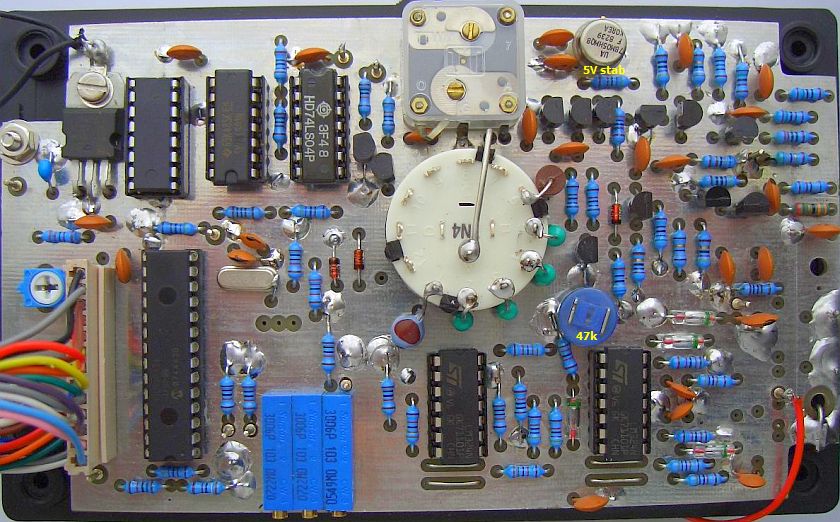

The ALC functions as expected and the signal level on TP1 can be adjusted between approx. 1.58 and 1.7 V.
For the time being the voltage level was adjusted to 1.58 V and the improved results (when compared to the original version) are reported in the table.
The 47 kΩ potentiometer (fig») is in its maximum position and therefore superfluous. If you decide to apply the above modifications then determine if the analyser works properly first before installing the potentiometer. It saves time in the construction and I have left it out in the diagram.
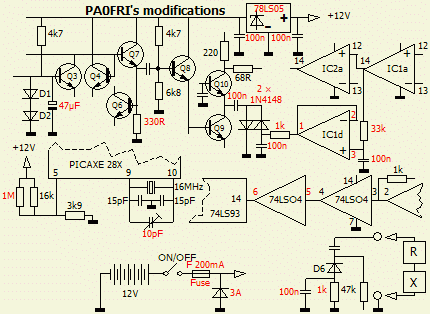
It was earlier on noticed that there were likely not enough buffers following the oscillator. One consideration was that the divider might also have an influence on the stability of the oscillator. The 74LS04 have six inverters yet only two were in use. Once a third inverter was activated («fig) the voltage on TP2 increased slightly and this proves that an extra buffer has its benefits.
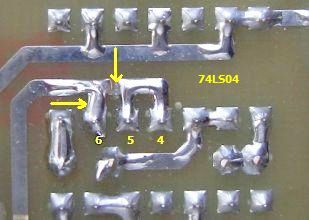
As a result I have made the experimental change into a permanent one. Pin 4 and 5 are already connected. Only (fig») the track between 4, 5 and going to pin 14 of the 74LS93 has to be cut and afterwards pin 6 is connected to the cut track going to pin 14. (Pin 4 and 5 stay connected with each other.)

The final results were measured with all the above modifications in place and the table («fig) shows that the average accuracy has improved and that at 50 Ω it is the highest.
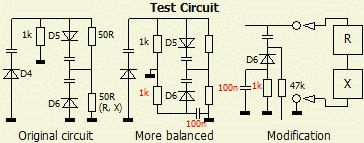
The design assumes that the voltage drop across D5 and D6 is equal when the bridge is in balance at 50 Ω. It was noticed that the current through D5 is not equal to the current through D6 (ID5 ≠ ID6) in the Wheatstone bridge. The series 1 k Ω resistor that is in series with D5 causes an imbalance. A 1 kΩ resistor needs to be put in series with D6 to correct this.
The output levels produced by D4, D5 and D6 are measured at pin 14 (TP14), pin 8 (TP8) and pin 7 (TP7) of IC1a.
Before the modification the output level at TP7 was not equal to TP8 (TP7 ≠ TP8) and neither were either of them equal to half the level of TP 14 (TP3 ≠ TP4 ≠ ½ TP14).
After the modification the level of TP6 is near enough to half the level of D4 (TP7 = ½ TP14) but TP7 is still not totally equal to TP8 (TP7 ≠ TP8). It is likely that this will improve when two matched Ge diodes are utilised and perhaps a 1 kΩ resistor needs to be placed in series with D4.
The remaining unequal levels of D5 and D6 require a different calibration procedure. The following has proved to be successful:
|
Calculation and calibration procedure |
|
|
(1) Apply 12V to the PCB. |
|
|
(2) Connect a non-inductive 50 Ω resistor across the terminals. |
|
|
(3) Set the frequency to about 2 MHz. |
|
|
Wait about 10 minutes. |
|
|
(4) Adjust the level of TP2 to exactly 4.5 V with P1. |
|
|
(5) Measure pin 14 of IC1a (was here 1.740 V). |
|
|
(6) Measure pin 8 of IC1b (was here 0.788 V). |
|
|
(7) Measure pin 7 of IC1c (was here 0.793 V). |
|
|
The multiplying factor is 4.5 ÷ Upin14 (here 4.5 ÷ 1.740 = 2.58620) |
|
|
(8) Adjust the level of TP3 to (2.58620 × 0.788 = 2.038) with P2. |
|
|
(9) Adjust the level of TP4 to (2.58620 × 0.793 = 2.051) with P3. |
|
The correct voltage levels for TP3 and TP4 can be calculated by multiplying with the factor (4.5 ÷ Upin14) in case that the levels on pin 7, 8 and 14 are different.
![]()